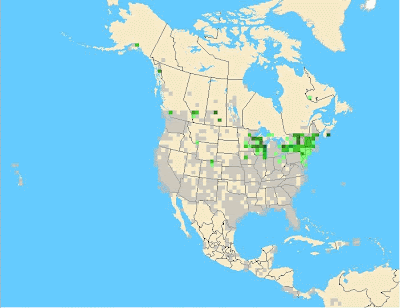In catching up on emails I discovered the majority of bird posts piling up in my inbox revolved around a specific winter finch: the White-winged Crossbill. This is a favorite . . . no, I'll go out on the limb and say it's the favorite winter finch of birders and naturalists everywhere. That's because of their odd-but-effective bill structure, adapted for prying open cones to extract the seeds, and their nomadic lifestyle which keeps birders guessing if they'll be absent, uncommon, or (rarely) common across the northern U.S. in most years.
 An eBird map of reported WW Crossbill sightings from last
An eBird map of reported WW Crossbill sightings from lastwinter (November 2007 through February 2008). Reports
were relatively few and spread across disparate locations.
When their preferred cone crops, hemlock, spruce, and larch, fail in one area they irrupt elsewhere, gracing the newly-found conifers along with birder's lists, delighting nature watchers, at least for a season. Then it's back to their seemingly erratic wandering (see the Kaufman's excellent post for more about their habits).
According to the local bird lists it seemed every conifer with cones (and it's a good year for many species, particularly several spruces) had crossbills. Sightings were rarely of one or a pair, almost always it was dozens or even hundreds, in one case thousands: Rochester birder Dave Tetlow recorded over 1,700 while conducting the sea watch count for two and a half ours at Hamlin Beach State Park, Monroe Co., NY. Obviously, it's shaping up to be an amazing year for WW Crossbills in the northeast and parts of the upper midwest.
 WW Crossbill sightings reported to eBird in November,
WW Crossbill sightings reported to eBird in November,2008. Lots of birds, and frequently encountered.
Saturday morning, while filling the feeders, I was reflecting on this, mentally mapping all of the possible conifers I encounter in our area and on my drive to Ithaca. I admit I'm a crossbill junkie, I could watch them for hours as they worry a cone, prying open and excavating the seed with their specialized bill. Had I paid attention I would have noticed the litter of cone debris covering the snow in our yard, something I've never noticed in our yard but I would notice later that afternoon. Turns out our spruces were the ones I should be eying!
 Click on the images for larger versions and better viewing.
Click on the images for larger versions and better viewing.Note the crossed bill tips and the colors: males are red, females are
yellowish and streaky. Both sport white patches in the wings.
While FeederWatching a bit later I saw a small flock of finch-like birds land on a spruce. Crossbills! I relinquished the binoculars so Donna and Reina could watch, figuring the birds would stick for a while. No luck. Donna had excellent views, Reina had trouble with the bins but did finally get an eyeful, then the birds flew.
 Crossbills continued to stream into the yard, swelling
Crossbills continued to stream into the yard, swellingthe numbers from a dozen to nearly a hundred birds.
Later that afternoon they returned. I bolted outside, no jacket and only Crocs on my bare feet but with the necessary optics. I followed a group moving from tree to tree, picking through the cones with amazing grace and speed. They were joined by more crossbills, a few Pine Siskins mixed in, and still more crossbills arrived. All told I had about ten unadulterated minutes with them before they moved on. Quickly counting the flock as it headed west I estimated 90 - 100 birds. The siskins didn't feel the same urgency, they stuck around the yard awhile longer.
There are still plenty of cones on our trees, and the conifers on my commute are heavy as well. I'm driving slower than usual now, hoping for another encounter.
Read the eBird article to learn more about this irruption along with strategies to find them. And if you do, be sure to contribute your sightings!
-





6 comments:
I don't think I've noted these before but will keep an eye open for them!
Exciting that this year I might just glimpse these passerine birds. Crossing fingers and toes!!
Thank you for posting the photos.
Great blog! And, what a wonderful post about these fascinating birds! I could watch a flock of crossbills working a hemlock for hours.
Thanks for the kind words about our blog. We're having way too much fun with it.
- Adirondackcountrygal - perhaps more important is to keep an ear open for them: seems a lot of the posts were of the "heard-first, seen-later." You can listen to a song at AllAboutBirds (and learn some other interesting facts about them!).
- Rouchswalwe - Though I'm extremely happy I got some photos I'm more determined than ever to take photography to the next level. I wish the photos had come out as detailed and colorful as I'd seen them live!
- Kimberly - Back at ya: thank you for your kind words! I look forward to your future posts, I've already added you to my "blog roll" thingy.
By the way, back to crossbills: feeders are a great place to watch for them, my first experience in Ithaca with both White-winged and Red Crossbills was at the feeder of Irby Lovette, our Director of Evolutionary Biology. And Kim has a great feeder experience (and photo), too!
How exciting! Here in my rock-infested yard I will continue to plant more conifers in hopes of one day having such a visitor.
Hi Jan m - in the meantime keep an eye on any/all spruces you see in your neighborhood. I've noticed many, many conifers are heavy with cones this year in our region.
But look close: even if they're on the cones, they're not easy to see at a quick glance. And, just in case, keep the feeders filled!
Good luck!
-Mike
Post a Comment